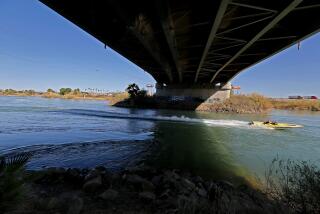Avoiding Troubled Waters
- Share via
During first-day orientation sessions, Brenda Roper of Alaska Wilderness Journeys talks to her trekkers, kayakers and rafters not just about the beauty that awaits them in Alaska, but about potential hazards, including diseases and infections contracted through contaminated waters. On her list is Giardia, the worldwide parasite that can lead to giardiasis, also known as backpacker’s diarrhea.
In what is now the height of the tropical adventure travel season at the other end of the globe--places such as the South Pacific, South America and Africa--it’s smart, experts say, for travelers to educate themselves about the hidden dangers of contact with the world’s unexplored waters. Among chief risks: giardiasis, schistosomiasis and amebic dysentery.
*
Giardiasis is found worldwide, according to the federal Centers for Disease Control and Prevention, with transmission occurring after ingestion of fecally contaminated food or water, exposure to surfaces contaminated with the parasite or person-to-person transmission through fecal-oral contact.
“We recommend filters for prevention of water-borne parasites,” said Dr. David Addiss, a medical epidemiologist at the CDC’s division of parasitic diseases.
But be sure the filtering devices will trap organisms as tiny as one micron, added Dr. Michael Kramer, a fellow at the CDC’s division of parasitic diseases.
Even then, there’s no guarantee of not catching anything from the water. “A one-micron [filter] does not filter out all viruses and bacteria,” Kramer said. Iodine tablets or boiling can further boost safety. Bring drinking water to a rolling boil for one minute at sea level, Kramer advised, and let it boil three minutes at altitudes of 6,500 feet or higher.
If precautions fail, symptoms of giardiasis include diarrhea, abdominal cramping, fatigue, flatulence, nausea, appetite- and weight-loss. Symptoms often persist for more than five days. Treatment with drugs will bring relief.
*
Another water-related hazard, schistosomiasis, affects about 200 million people worldwide, according to the CDC. This infection is caused by parasites that use fresh water snails as intermediate hosts. The infected snails, in turn, release minute, free-swimming larvae that can enter the unbroken skin of their human hosts, where they grow inside the blood vessels and produce eggs that may travel to the urinary tract, the gastrointestinal system and other organs. Even brief exposure to contaminated water can lead to infection.
Within days of becoming infected, a rash or itchy skin can occur, according to Kramer. If an acute infection occurs, other symptoms--such as fever, lack of appetite, weight loss, abdominal pain, weakness, headaches, joint and muscle pain and diarrhea--may arise within two or three weeks of exposure. The eggs can be found even eight weeks after exposure, according to CDC experts.
But most acute infections are without symptoms.
“Most people won’t realize they are affected,” according to Kramer. Whether the afflicted will have health problems depends on the severity of the infection and whether they are infected repeatedly. “After many years of repeated infection, the parasite can damage the liver, intestines, lungs or urinary bladder,” according to the CDC. But even without treatment, damage to these organs is rare in travelers who have brief exposures.
Those who suspect they have been exposed to schistosomiasis should see a doctor.
Blood tests or microscopic exams of the stool and urine (to detect eggs) help with the diagnosis, according to Dr. John Horton, a Westlake Village family physician who specializes in travel medicine. The drug treatment of choice is praziquantel (Biltricide), Horton said, and “one dose takes care of it.” Research to develop a vaccine is ongoing.
This infection is common in Africa, warned Horton. Asia, South America and the Caribbean also pose risks, according to the CDC. Even waters that look pure can be a hazard. Case in point, said Addiss: glittering Lake Malawi in southeast Africa. The lake is definitely not free of the risk of schistosomiasis, according to CDC research conducted there in 1993. Blood tests were given to 1,000 resident expatriates and travelers. “One-third had antibodies,” said Addiss, indicating evidence of infection. “We were expecting maybe 2%. Swimming in the lake was a major overriding risk factor.”
Countries where the infection is most common include Brazil, Puerto Rico, St. Lucia, Egypt, most of sub-Saharan Africa, southern China, the Philippines and Southeast Asia, according to CDC experts.
Travelers considered at greatest risk are those who wade or swim in fresh water in rural areas where poor sanitation and snail hosts are present. The disease can’t be caught by wading or swimming in salt water, according to the CDC. And swimming in adequately chlorinated pools is considered safe.
*
Amebic dysentery, a diarrhea that can include painful bloody bowel movements, is acquired by drinking or eating fecally contaminated food or water or by person-to-person contact. Symptoms usually occur seven to 21 days after exposure.
Treat water in the same way as for Giardia prevention, Addiss advised. Avoid ice cubes and foods such as fresh vegetables and lettuce, which may have been rinsed in contaminated water, added Kramer. Another good idea, Kramer said: follow the “Boil it, peel it, cook it or forget it rule.”
The Healthy Traveler appears the second and fourth week of every month.
More to Read
Sign up for The Wild
We’ll help you find the best places to hike, bike and run, as well as the perfect silent spots for meditation and yoga.
You may occasionally receive promotional content from the Los Angeles Times.






